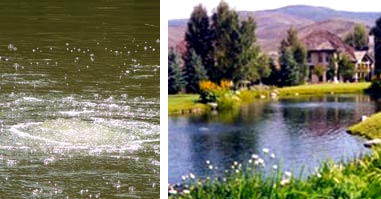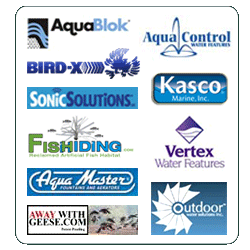Home > Lake and Pond Ecology > Lake and Pond Ecology
Lake and Pond Ecology - Limnology Basics
EUTROPHICATION
All lakes age the same way — they begin as oligotrophic lakes, and age to become eutrophic lakes. Allowing nutrients to accumulate in our lakes from agriculture, fertilizers, streets, sewage, and storm drains speeds up this process. To find out how to slow this process go to "Green Up Your Lawns, Not Your Lakes"
1. Oligotrophic Lakes (Pristine Clear Lakes) Oligotrophic Lakes are those that are generally clear, deep, have low primary production, and are clean pristine lakes. The food chain in oligotrophic lakes is very structured and is capable of sustaining a fishery of large game fish. These lakes tend to be the most aesthetically pleasing of lakes due to their clear blue water. In oligotrophic lakes, there is usually a very high measure of water clarity reading (in relation to the depth of the lake) and low phosphorus and chlorophyll readings.
2. Mesotrophic Lakes (Most Lakes) Mesotrophic lakes are in the boundary between oligotrophic lakes and eutrophic lakes. They have more nutrients and production than the oligotrophic lakes, but not nearly as much as eutrophic lakes. Mesotrophic lakes have some accumulated organic matter on the bottom of the lake, as well as an occasional algae bloom at the surface. They are usually good lakes for fishing, as they are able to support a wide variety of fish. In the late summer, the hypolimnion can become depleted of oxygen, which limits cold water fish and causes phosphorus cycling from the sediments. Mesotrophic Lakes have water clarity, phosphorus, and chlorophyll readings between those of eutrophic and oligotrophic lakes.
3. Eutrophic Lakes (Very Nutrient-Rich, Problem Lakes) Eutrophic Lakes are the most productive lakes, and thus support a very large biomass. These lakes are normally weedy and subject to frequent algae blooms yearly. There is often a large amount of accumulated organic matter on the bottom of the lake. Eutrophic lakes support large fish populations. Eutrophic lakes are susceptible to oxygen depletion in the hypolimnion, and shallow eutrophic lakes may be vulnerable to winter and summer fish-kill situations.
Eutrophic lakes have low water clarity readings in relation to the depth of the lake and high phosphorus and chlorophyll readings. Most problems occur in Eutrophic Lakes. Nearly all urban lakes are now Eutrophic in nature.

Degraded or Eutrophic ponds and lakes can be characterized by low levels of dissolved oxygen and highly stratified waters, where warm, oxygen-rich water is suspended above cool, oxygen-depleted bottom waters. As anaerobic conditions begin to develop in deeper water, naturally occurring aerobic microbes can no longer perform beneficial tasks, such as waste digestion and water purification. With time, water quality greatly decreases leading to unsightly blooms of algae, the accumulation of aquatic sludge and the build up of gases, such as methane and hydrogen sulfide, that are well know for their offensive odors. Low-oxygen levels can also lead to fish death and winter kill. Luckily, degraded ponds and lakes can easily be enhanced with the addition of a Bottom-based Diffused Aeration System (Lake Bed Aeration) which acts to increase dissolved oxygen levels while eliminating stratified waters. Aerobic microbes recolonize deeper water where they rapidly begin to digest accumulated sludge and improve water quality.
By targeting the 'source'of the problem, not just its 'symptoms,' the need for harmful chemicals can lesson, saving money and time!
DISTRIBUTOR




